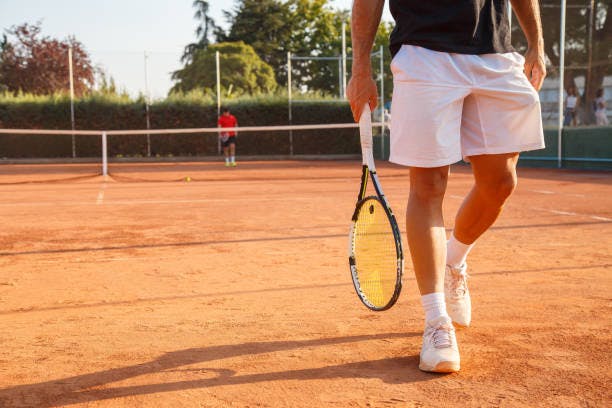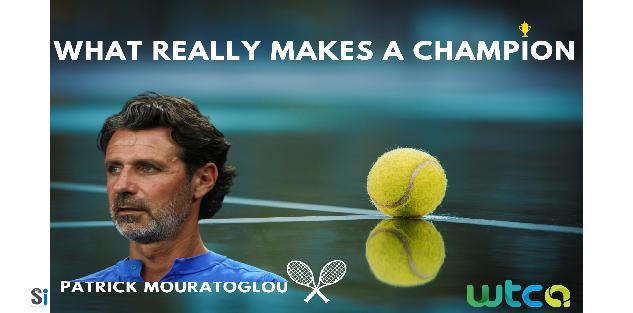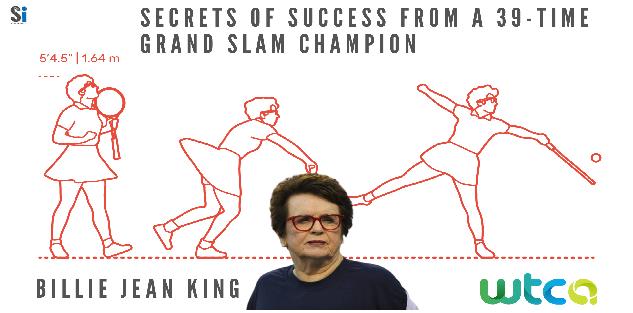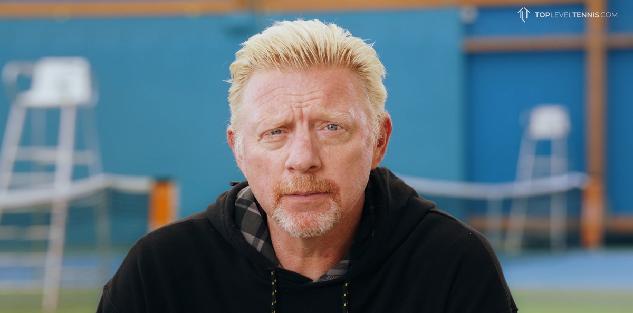Featured courses
- Four Tips to Turn Your Tennis Forehand Into a Weapon by Grant Young
- Tennis Legend Billie Jean King’s 4 Responsibilities as a Player by Grant Young
- Two Top Priorities For Success in Doubles Tennis by Grant Young
- Three of Tennis Whiz Lisa Dodson’s Tips to Improve Serves by Grant Young
- Three Elite Tennis Ball Machine Drills by Grant Young
- Three Keys For Correcting Tennis Serving Mechanics by Grant Young
- Five Tactical Tips to Win More Tennis Matches by Grant Young
- 4 Lessons Patrick Mouratoglou Learned From Coaching Serena Williams by Grant Young
- Four Effective Backhand Tennis Drills by Grant Young
- Two of Legendary Tennis Coach Paul Annacone’s Crucial Player Development Tips by Grant Young
- A Step-By-Step Guide To Mastering The Serve by Krsto Arsenijevic
- How to Dominate the Clay Court in Tennis by Krsto Arsenijevic
- 10 Essential Tennis Drills Every Coach Should Know by Brandon Ogle
- 8 Pre-Game Exercises to Prime Your Tennis Team for Competition by Neil Brown
- 7 Proven Tips To Develop Your Net Game in Tennis by Krsto Arsenijevic
- 10 Essential Tennis Drills Every Coach Should Know by Krsto Arsenijevic
- Developing Players - Two-handed backhand by Ramon Osa
- 6 Simple Warm-up Exercises For Tennis Players by Krsto Arsenijevic
- How to Beat a Serve-and-Volley Player by Krsto Arsenijevic
- How To Build Your Kinetic Chain Like Djokovic by Aiden Lefebvre
- How to neutralize a lefty in Tennis by Aiden Lefebvre
- 5 Tips To Improve Your Tennis Game Today by Krsto Arsenijevic
- Everything You Need to Know Before Buying New Tennis Shoes by Brandon Ogle
- Amp up your tennis practice with situational play by Neil Brown
- Tennis Equipment List by Brandon Ogle
- How to Master The One-handed Backhand in Tennis by Krsto Arsenijevic
- Modern High School Tennis Coaching Obstacles by Neil Brown
- Increase Your Tennis Fitness Level With 3 Easy Drills by Krsto Arsenijevic
- How to Successfully Hit a Two-Handed Backhand by Brandon Ogle
- How to Become a Grass Court Specialist in Tennis by Brandon Ogle
- How to Dominate the Hard-Court like Serena Williams by Brandon Ogle
- Hit a Drop Shot to Keep Your Opponent Off-Balance by Brandon Ogle
- New Tennis Injury Findings Linked to Neutral & Closed Stances by Oscar Wegner
- CHATTING WITH TENNIS PRO BRUCE CONNORS by Brandon
- How to Become a Mentally Strong Tennis Player by Brandon Ogle
- How to Win the Game of Angles by Hitting Cross-Court Shots by Eric Mahnke

How to Dominate the Clay Court in Tennis
In tennis, there are only a few primary court styles: grass, hard court, indoor carpet, and clay. All tennis players seem to have their favorites. Clay courts, which are much more common in Europe, tend to play differently than the other types. Throughout this article, I’ll break down some of the essentials to mastering the clay court. Rafael Nadal said, “I play each point like my life depends on it.” In many ways, this quote is a perfect attribute to the clay court game.
Difference Between Clay, Hard and Grass Courtsurts
One of the most prevalent differences between these three types of courts is the speed. The clay courts play much slower than the others. Most of this is due to the fact that the balls bounce higher and slower, which decreases the amount of winners. The points last longer, thus requiring players to hit consistent shots and have the ability to play defensive tennis. On grass courts, the ball bounces low while maintaining the speed. As a result, players utilizing the serve and volley approach will succeed on grass. Lastly, hard courts display similar characteristics to grass, as they tend to play quick.
Another primary difference is the costs. Although clay courts are cheaper to construct, they do require a heavy deal of maintenance. Classic Turf states “they need to be rolled, lines need to be painted more frequently, and the amount of water let on the court has to be watched closely. They’re kind of a pain to maintain.” Similarly, grass courts also tend to be high in maintenance costs. It is probably safe to say that these high maintenance costs have been the factor that has led to more and more hard courts being built in North America.
Consistencyency
In terms of shots, a player needs to display consistency to be successful on clay courts. While, in reality, a tennis player has to always be consistent to win, the importance is magnified on clay. Arantxa Sanchez Vicario, who won three French Opens, always tried to run down every ball. By showing perseverance in this manner, you attempt to give your opponent one more chance to miss. Since clay plays much slower, it also allows you plenty of time to get into position for a return. In order to properly take care of this advantage, you need to hit with topspin. While some deceleration will occur when it hits your opponent’s court, it won’t be as severe. The best advice in terms of consistency is to not try to win every point with one shot, rather make your opponent think they need to blast away for a winner.
Staminamina
One of the key reasons behind Rafael Nadal’s success on the clay courts against some of the best in the world, like Djokovic and Federer, is his impressive stamina. Nadal’s workout regimen consists of exercises to work a wide range of muscles. Going along with the point of consistency, you have to be able to run down every ball you can on clay. However, if your opponent over matches you in the stamina category, they will be able to do this more effectively. This requires you to be well conditioned, so you’ll be able to run down your opponent’s hardest shots and outlast their power.
Adjusting to the Slipperinessness
Clay courts also tend to be more slippery, especially blue clay. This characteristic compels you to learn how to take advantage of it through practice. One area where the slipperiness comes into play is changing directions. If you’re running one way to hit a shot, the traction isn’t great to be able to turn around. Another element to capitalize on the slipperiness is the capability of sliding. An article on USTA discussed the art of sliding perfectly. “Toss a ball high enough to allow for a high bounce, and practice sliding into the shot. The bounce may move the ball away from you; however, swing your racket through the shot, even if the ball is not there, and work on staying balanced. This is putting biomechanical feedback to work. Once you are grooved with your new sliding ability, start practicing with a partner, and hone your skills.” A final recommendation I give would be to abandon the serve-and-volley approach on clay. This methodology will struggle, because your opponent will have plenty of time to set up.
Patienceence
It is vital to understand that you are not going to win points with one shot. Even some of the greatest servers in the game like John Isner struggle on clay because it requires patience to be successful. You have to keep your opponent running back and forth on the court. This will not only take a toll on their stamina, but the slipperiness of the clay might become a factor. Along with this, take advantage of the added set-up time to hit with heavy topspin. When a ball with topspin hits into the clay, it often bounces higher than the average volley. This will likely put your opponent in an awkward position where they can’t hit a strong shot back.
Shoeshoes
Even though regular shoes may work on clay, you are going to need clay court-specific shoes to slide and excel on clay. Tennis Warehouse Blog mentions how the primary difference between clay court shoes and hard court or grass ones is the outsole. “The outsole of a clay court shoe will usually feature a full herringbone (the zig zags) tread pattern. This pattern won’t allow the clay to lodge to the outsole so you can get a better grip when you try to start, stop or change directions.” Furthermore, this pattern allows the clay to get dislodged by hitting your racket against the shoes. The primary advantage these shoes provide is the traction to be able to move in all directions and slide like Nadal.
Mental Toughnessness
Operating on clay courts requires you to instill the mindset that you’re never out of it on clay. This doesn’t just apply to individual points, but the entire match. Due to the endurance issues, players can dominate early on before falling apart as the match wears on. If your conditioning is up-to-par, you can let the opponent blast away early while forcing them to work the full court. Mental toughness is also critical in that you must be able to manage your stamina across the entire match. You can’t let your opponent out-smart you into thinking you can hit lots of winners. Remember the surface you’re playing on; clay isn’t usually won with an offensive approach.
Rafael Nadal’s Dominanceance
Throughout history, there have been many players that have held the title of the king of clay. Most recently, it has been the Spaniard, Rafael Nadal. As of April 2014, Nadal had amassed a 300-21 record on Clay, including 43-6 in clay finals. He continuously dominates at the French Open. Much of his success is due to the fact that he excels at the points listed throughout this article. Nadal possesses superior stamina, coupled with above average strength, which allows him to work over opponents consistently.
Try It Out Out
It’s hard to gain a complete understanding of clay courts until you play on them. Although they are limited in North America, I’d recommend trying one out if you have the opportunity. As I mentioned throughout this article, many of the characteristics of clay court dominance require experience and provide a much different strategy than hard court or grass. Just remember, “Try for everything,” when you’re playing on clay.



